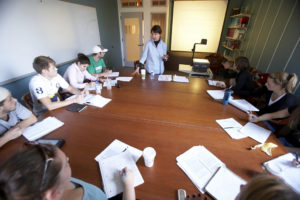 This summer, I revisited the excellent book Discussion as a Way of Teaching: Tools and Techniques for Democratic Classrooms by Stephen D. Brookfield and Stephen Preskill. I’d like to share some key ideas from their text (and encourage you to check out the book from the Bailey/Howe collections).
This summer, I revisited the excellent book Discussion as a Way of Teaching: Tools and Techniques for Democratic Classrooms by Stephen D. Brookfield and Stephen Preskill. I’d like to share some key ideas from their text (and encourage you to check out the book from the Bailey/Howe collections).
I should note that the ideas and approaches shared in this book can be applied in classrooms with a range of size and content areas. Even in a large course, there are opportunities for students to simply pair with a neighbor and engage in a discussion. After all, according to the authors, discussion is “an alternatively serious and playful effort by a group of two or more to share views and engage in mutual and reciprocal critique” (Brookfield & Preskill, 2005, Chapter 1, Section 2).
To unpack the definition a little further, there’s something lovely about being given the expectation of mutuality, when opposition and polarity seem to inundate the airwaves. To be clear, in a discussion, while opposing ideas may indeed emerge, perhaps with no consensus reached, by Brookfield and Preskill’s definition, the people engaged are doing so with the common intent of learning and growing by listening, thinking, and articulating.
Consider, then, these four purposes of discussion outlined in the book:
- to help participants reach a more critically informed understanding about the topic or topics under consideration,
- to enhance participants’ self-awareness and their capacity for self-critique,
- to foster an appreciation among participants for the diversity of opinion that invariably emerges when viewpoints are exchanged openly and honestly, and
- to act as a catalyst to helping people take informed action in the world. (Brookfield & Preskill, 2005, Chapter 1, Section 2).
What I appreciate about these purposes is the challenge they provide me, as a teacher, to create opportunities for my students where the discussion is elevated and potentially transformative. Please do recognize that I use the word “challenge” with all honesty. Facilitating discussions that meet these purposes is not always easy. Fortunately, Brookfield and Preskill provide more than a philosophical perspective. They also share numerous techniques and approaches, from setting expectations to navigating the complexities that social identities (race, class, gender) bring to participating in discussions.
I haven’t counted, but I think there are close to 100 tips in this book. I’m going to share three, and hope you comment with additional ideas (from the book or your own experiences):
Hatful of Quotes: The instructor/facilitator chooses 5 or 6 quotes from a reading, and puts multiple copies of each quote into a hat (enough so there is one slip of paper for each student). Students draw a quote out of the hat and are given time to read it silently and reflect on the content. Then, in no particular order (popcorn style), students read their quote out loud and share some reflection. If students are shy or wary of speaking, they may wait until the end and at least read their quote; perhaps they will feel confidence to agree with other interpretations or supplement with their own ideas. (Brookfield & Preskill, 2005, Chapter 4, Section 8)
Buzz Groups: These small groups can be used during a lecture-heavy class (suggested to be facilitated once or twice per session). Three to four students join together for three minutes to discuss a topic raised in the lecture. Examples of question prompts the authors suggest include:
- What’s the most contentious statement you’ve heard so far in the lecture today?
- What’s the most important point that’s been made in the lecture so far?
- What’s the most unsupported assertion you’ve heard in the lecture so far?
- Of all the ideas and points you’ve heard so far today, which is most obscure or ambiguous to you? (Brookfield & Preskill, 2005, Chapter 3, Section 3)
Students are asked to keep track of points of consensus or disagreement. Then, the instructor asks (in the full group) for a representative sampling of comments.
Conversational Moves: Students are given, randomly, a slip of paper when they enter the room with an instruction (a “move”) for participating in that day’s discussion. The authors provide 12 examples including:
- Ask a question or make a comment that shows you are interested in what another person has said.
- Ask a cause-and-effect question – for example, “Can you explain why you think it’s true that if these things are in place, such and such a thing will occur?”
- At an appropriate moment, ask the group for a minute’s silence to slow the pace of conversation and give you and others time to think. (Brookfield & Preskill, 2005, Chapter 5, Section 5)
Instructors could come up with any moves they would like. It is recommended that time is saved for the end of class to hand out the full list of questions and debrief the experience.
Reference
Brookfield, S. D. & Preskill, S. (2005). Discussion as a way of teaching: Tools and techniques for democratic classrooms [Kindle version]. Retrieved from Amazon.com.
